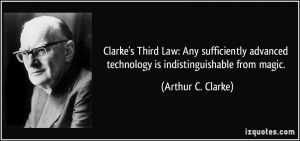
For those that want to utilize it, ancient advanced technology is a narrative aspect to the Shadow World setting. Advanced technology was not just achieved by the Althan/Ka’ta’viir civilization in the 1st Era, but also utilized by several other notable cultures during the Interregnum: Taranian, Jinteni & Worim.
When we think of technology in fantasy role playing we often visualize laser pistols, laser swords, shield devices, power armor—objects that are just more powerful version of standard fantasy weapons (crowsbows, swords, armor etc). I posted up an older file on using technology in SW here, but the convenient fact is that although it’s tech, it can be handled easily within the RM fantasy magic rules. Laser Guns cast “Firebolts”; Lightsabers inflict Electricity, Fire or Plasma Crits; Anti-grav belts cast “Levitation”, etc.
While there have been numerous ancient high-tech civilizations and contemporary cultures that use “science” (Krylites), none of them reached the advancements of the Althans or Ka’Ta’viir.(Tech Level 13+). Truly advanced technology can transcend common form factors and seem inscrutable to normal understanding. In other words, they will seem magical.
Here are a few advanced technologies that might be a good fit in your Shadow World game:
Post Physical Entities: This is a term often used to describe an “upload society” where consciousness can be transferred to a computer network, object or virtual emulator. Shadow World modules already features stored Ka’ta’viir intelligences (Cloudlords) and the Thalan are a good example of a post-physical entities (PPE’s). From a game standpoint, introducing an ancient Althan/Ka’ta’viir consciousness could be interesting. The entity would probably have their own agenda, limit information flow and perhaps “guide” the players to their own purpose. This could provide a useful guide for the GM to direct the PC’s through the adventure or tie multiple adventures into a greater campaign. Mechanically, PPE’s should be treated as an NPC, only limited by the ability to interact with the physical world. Additionally the PC’s may not even realize the “entity” is an uploaded consciousness or ancient being.
A.I.: Similar to Post Physical entities, A.I.’s are already featured in SW. Two prominent ones are the A.I. in Andraax’s tomb and Morik in Eidolan. Unlike PPE’s, A.I.’s are a technical/software artifact and may be limited by their learning ability, programming and information resources. Like PPE’s, A.I.’s should be treated as NPC’s.
Time Control: Ka’Ta’viir use a “Chronagenic” process to hibernate. Not to be confused with a cryogenic process; rather than freezing or preserving a person through physical or biological means the capsule seals the entity into a time singularity. It’s not clear whether the Althans had additional control over time (barring localized events). Jinteni also had some time dilation abilities (Emer III and Inn of the Green Gryphon). Time travel and control have always been tricky in RPG’s: a GM needs to decide the long term effects of causality and impact on the game narrative. There are three basic mechanisms for time manipulation: devices (machines & portals), spells (I’ve uploaded a Time Mastery spell list on the RM Forums ) or Essaence effects (Essaence Storms and Foci). Time Travel introduces an introducing plot device to allow PC’s to explore other parts of the immense SW timeline. In fact, you could probably roll randomly for page, paragraph and line or 1-100,000 years to pick a date in the timeline to send the players. At the least, they could be spectators to interesting historical events and experience some of the intriguing past of Kulthea!
Matter/Energy Conversion: A truly advanced society will have mastered matter – energy conversion. This is more than simple fusion, it’s a two way process to generate power from any matter OR the ability to produce objects or material from energy. This probably has less game-world impact than other technologies but it does allow for devices to be powered indefinitely (by harvesting small amounts of matter for energy), self-repair of devices and vehicles or for generating objects “out of thin air” like a Wish spell.
Molecular Assembly: Before they have the ability of creating matter from energy, a post scarcity society will have obtained the ability to create any object from scratch using “feedstock” raw material. These Replicators or “Cornucopia Machines” are just highly advanced 3D printers. In Sci-fi and economic theory, such a machine would be a major societal disruptor allowing for the easy creation and accessibility of wealth. This technology was the basis for the post-scarcity society presented in Star Trek. In your SW game, this technology could be useful but not unbalancing on a limited basis—perhaps program/design access is prohibited except to authorized users (i.e. weapon mfg)
Mal-Metal: Malleable, changeable or programmable materials would be common in an advanced society. This allows for amorphous forms—wings that can change shape, weapons that can morph into others with a thought, adjustable cloaks, armor that can distribute impacts or force etc. This type of technology would be very useful to a PC and would be indistinguishable from common magic item tropes. Obvious examples would be morphing weapons (retain weight/mass but changes shape), fluid bracers that cover the arms as greaves at a thought etc. In SW, “Malloys” (malleable alloys) could combine advanced tech with materials like Keron, Eog or Ithloss.
Bionomics: A step past cyborg implants, Bionomics are organic based technological capabilities built into a person at the molecular and cellular level. These could be energy projections (disruptors, beams), shields (force fields or environmental shields), wetware computing power for advanced mental and calculative abilities. Unless they were born from a very specific parentage, installation of Bionomics would require substantial surgical procedures and DNA manipulation. Bionomic abilities could be treated as innate spell abilities powered by a reservoir of cell energy (use CO. stat?). In our campaign, Bionomic technology was a significant part of the Xiosian heritage.
Von Neumann Self Replicators: These machines combine the technologies of molecular assembly and matter/energy conversion to build copies of themselves. This is a powerful concept but might not have too much relevance in a gaming environment. However these could also work on a nano scale—“Nannite” clouds that replicate and perform programmed tasks (healing, buffs, metamorphis etc). Examples of “Nannites” might be found in upcoming SW material!
Solid State Technology: When we think of machines we often conflate it to devices with moving parts and collections of components. An advanced society will utilize microtization, exotic meta-materials and atomic level functionality to produce devices that work as machines but won’t have moving parts. To PC’s this will give machine or software functionality to solid objects–just like magic items.
Neural Control/Interface: The Ka’ta’viir were not only advanced technologically, they were able to utilize the Essaence AND access Psionic/Mind powers. At the height of their powers (Late Imperial Era) many devices were controlled through mere thought. In the game, neural interfaces should be treated as quasi-mentalism or accessed via “Attunement” skill (treat as Absurd or -150 due to the complexity of this technology or allow a PC to have some Althan heritage and reduce the penalty).
While primarily a fantasy setting, Shadow World also has elements of a post-apocalypse setting and a sci-fi setting. Maybe the PC’s will initially be unaware they are encountering technology and not magic but these elements could add flavor to your campaign!








The challenge I see with RMU as opposed to RM2 is the apparent lack of willingness to look beyond fantasy (and even then it’s their definition of fantasy). RM has always suffered (IMO) from the lack of a solid, accessible setting, and RMU just seems to accelerate that trend. They also took steps (especially in the combat system) to render it almost useless for non-magic settings if you leave it RAW. The flexibility that came with RM2 (and even RMSS in its own way) seems to be disappearing.
In addition in a recent comment Hurin had noted the amount of HARP that seems to have found its way into RMU. There is nothing wrong with HARP but HARP is not Rolemaster and definitely not RM2!
That got me thinking. Last year I bought HARP Fantasy and HARP SF. I bought them because I want to run a SF game soon and as I have said many times before I have lost my Spacemaster books.
So HARP is certainly not locked into a fantasy setting and not into one single fantasy setting. Shadow World is statted out for HARP and HARP has its own core setting of Cyradon. HARP SF plays out in Tintamar but by default it also shares the same setting as Kulthea and Spacemaster because of the Shadow World connection.
One of the things I like about HARP is that the last release was to truly unify the fantasy and sf rules and make them interchangeable. I only needed the fantasy rules as monsters make great aliens.
There is a massive gulf between RM2 and HARP and I agree there is a lot of HARP in RMU. The skill system is the same, character creation is very similar. The move in RMU to less combat tables is almost a single step towards the HARP way of thinking and that I think is the problem with RMU. The only weakness as I see it with HARP, looking from a RM background point of view, is the combat system and the criticals in particular. The same old critical comes around again and again way too often and even in the same fight. The rest of the combat system works really nicely as far as I can tell.
Another interesting thing is that the HARP forums are far busier than the RM forums if you exclude the BETA test forums. If you include them then you also need to include the HARP development forums as well. I see a far greater variety of voices in the HARP debates than in the RM ones these days. There is an active HARP community around the game and new HARP books are eagerly awaited,even if most of them are just re-releases to bring them in line with the unified Fantasy/SF rules.
Whether HARP’s firearms are as good as intothatdarkness’s firearms is a completely different question but the fact remains that HARP does have viable settings and it does have modern day and SF elements that make it go well beyond the fantasy genre.
I think RMU is trying to learn from HARP but is struggling to take the old guard with it to some extent. Which is a pity as we are the old guard.